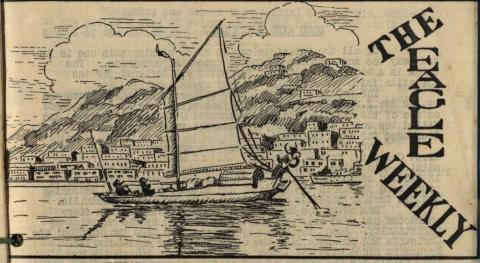18 May 2012
We get a fascinating insight into life on board a Royal Navy aircraft carrier in the inter-war years.

Such magazines were reasonably common but very rarely survive, certainly in such large runs, and indeed our holdings of this title appear to be unique in publicly accessible institutions. The Library is very grateful to a donor who found this item during a house move and very generously offered it as an addition to our collection. Its survival is almost certainly largely due to its covers, which the last issue for 1933 explains were ‘available at the bookstall’, having been printed specially in Hong Kong.
That men were willing to buy such covers demonstrates the value attached to such magazines, and the drawing on the right suggests that they were in high demand:
The editor goes on to add that ‘a punching machine is available in the Armament Office for those readers who wish to bind their copies’. This casual commandeering of naval equipment neatly echoes the charming informality and ad hoc nature of the publication. While by taking advantage of both of these measures to bind his copies the original owner preserved it in good condition, we might wish that his use of the Armament Office’s punch machine had been a little more careful, as words and images are sometimes cropped by the holes.
HMS Eagle (1918)
The Eagle itself has an intriguing history, as it was laid down by Armstrong-Whitworth in 1913 as Almirante Cochrane, destined for the Chilean Navy.
The Library collection includes the firm’s machinery specifications for the vessel in this first incarnation (PBB9404).
However, work on her was halted by the outbreak of war, and in 1917 she was purchased for conversion into a Royal Navy aircraft carrier. Launched in June of 1918, she was significant in being the Royal Navy’s first carrier to have an ‘island’ design, where bridge, mast and funnel were concentrated in one place, and also the first to have a two-level hangar.
The design is also recognisable in a looser sketch from the Eagle Weekly.
The magazine dates from the period immediately after a major refit which began in Devonport in the summer of 1931. While this was completed in November 1932, it took several months before the ship was actually staffed and ready for active service, and so the first issue, from 7 May 1933, can announce that ‘we feel thoroughly in commission now’. However, the editor displays a typical contempt for the wider service and its operation, remarking of the refit that ‘the ship is gradually getting rid of the remains left behind by Devonport Dockyard’.
HMS Eagle went on to serve in the Second World War, but was sunk with the loss of 160 lives by U-Boat U-72 in August 1942.
Life on board
The journal’s coverage is diverse, offering some lengthy and historically accurate accounts of places visited, such as Malta and the Suez Canal, alongside much fairly broad humour at the boredom and discipline of daily life. Small incidents are often returned to repeatedly for weeks afterwards. For example, one month after the partial flooding of a small area of the ship, the crew are still being jocularly advised that ‘The Paymaster Commander wishes it to be known that Marines should not normally be arranged to be washed into the ship’s galley at the moment that breakfast sausages are cooking. The ingredients of the said sausages are considered satisfactory without the addition of salt water and Marines in generous proportions’.
Many aspects of life are predictably unpopular, for example visiting the Medical Officer for inoculations.
There is also much satirical humour at the expense of the training offered.
Romantic aspects of life are perhaps unsurprisingly of surpassing interest to the writers, and the shadowy figure of ‘Matron’ has a more or less regular column commenting on issues of welfare. While the broad intention of such messages is clear enough, their exact focus often evades us. The level of knowledge of others’ lives which they imply is a reminder of the enforced camaraderie of such a vessel.
A happily preserved piece of social history, Eagle Weekly is all the more valuable to the Library in that we already have holdings of the Eagle Express, a similar periodical printed much later aboard another HMS Eagle, another carrier launched in 1946 and remaining in service until 1978. Both will be available to readers on request in the Caird Library from the resumption of full service (please check our website for updates on progress: http://www.rmg.co.uk/cairdlibrary)
Richard, Assistant Librarian